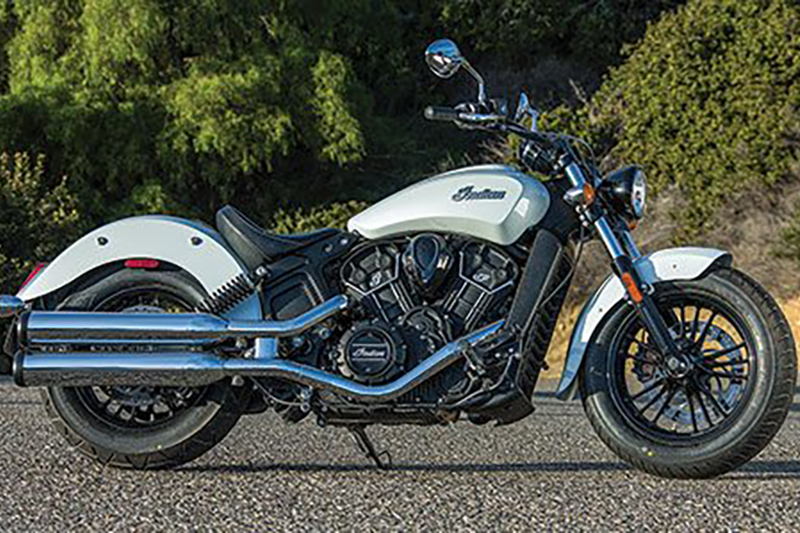2016 Indian Scout Sixty

Road Test Review
Now that Indian has been successfully reborn with the debut of the Chief series in August of 2013 (under the auspices of Polaris Industries, Inc., which also produces the Victory brand), the company has been rounding out its lineup with additional models. After leading with big-inch cruisers based upon its classic heritage (the original company was founded in 1901), Indian introduced the Scout for 2015, a much more technically advanced machine whose counterbalanced 60-degree V-twin motor features liquid cooling, four valves per cylinder and dual overhead cams, while still maintaining that classic cruiser stance. A cast-aluminum frame holds it all together. Indian considers that the Scout models are the type of machine the original company would likely be building today had it remained in continuous production.
Now for 2016, Indian has released a new model called the Scout Sixty, a more basic but similar-looking machine priced around $2,000 less that is aimed at the entry-level crowd. While the Scout features a 69-cubic-inch motor (1,133cc) with a bore and stroke of 99.0 x 73.6mm, a 6-speed transmission, lots of chrome and a leather solo seat, the new Scout Sixty displaces a less-threatening 999cc (or 61 cubic inches) by virtue of its smaller 93mm bore. It has a 5-speed transmission, vinyl solo seat and its styling features mostly blacked-out components. Both require 91-octane premium fuel, and stow it in their 3.3-gallon tanks. While Indian states that the Scout generates 100 horsepower and 72.2 lb-ft of torque, it claims only 78 horses and 65 lb-ft for the Sixty version, making it more a “son of” version rather than simply another iteration of the same model.
The first things the rider notes when climbing aboard the Scout Sixty is that its solo seat is placed just 25.3 inches above the pavement, and because its hefty 561 pounds of wet weight is carried so low, the bike feels solid rather than massive. The Sixty is only three pounds lighter than the Scout, so both are still a lot of bike to push around. The solo seat is bucket-like and holds the rider in place, which limits the opportunity to move around and change position; this can become tiresome in about 30 miles.
Fire up the Scout Sixty with its electronic fuel injection, and a throaty idle emanates from its chromed split dual crossover exhausts. After circulating through the 5-speed gearbox, power reaches the rear wheel by means of a belt final drive.
Out on the road, the rider soon becomes accustomed to the feet-forward riding position behind the wide handlebar. The fork is reasonably compliant, but those laid-down shocks with their mere three inches of travel are far less so and send the more pronounced road shocks into the rider. With such a low seat height and short-travel shocks, I was soon scraping pegs and eventually boot heels on a twisty road, and was pleased to see that my daughter, Julia, was doing likewise.
Because the Scout Sixty is considered by Indian to be its entry-level machine, Editor Tuttle suggested that we solicit feedback on it from my 22-year-old daughter, Julia, who has been riding just a year on her Honda CBR300R. Though originally leery of riding a bike with three times the displacement and twice the weight of her little Honda, Julia happily noted that the bike was very controllable and manageable, thanks to its mellow, torquey power, low seat and center of gravity. She did find that the stronger clutch pull became tiring for her, but not so for Dad. The rear exhaust pipe passes close to the right thigh, and we both noted the unwelcome heat when we strayed too close. The bike’s long 61.5-inch wheelbase made for lazy turns in the twisties, but delivered welcome stability at highway speeds.
Stopping power is provided by a pair of 298mm brake rotors, the front gripped by a two-piston caliper and the rear by a single-piston. When he tested the Scout in our November 2014 issue, Senior Editor Greg Drevenstedt reported that the brakes were underwhelming. While the two models share the same braking system, I felt that the brakes on our test Scout Sixty were adequate. Note that anti-lock brakes are available on the Scout but not on the Scout Sixty.
Yes, Julia and I agreed that the Scout Sixty could use a cushier seat, better shocks and greater cornering clearance, all of which are potentially available through Indian’s accessory catalog that offers a leather solo seat and performance Fox shocks. Other items include windshields, wire wheels, cast wheels with machined accents, chrome, mini apes, a performance exhaust system, a passenger seat with backrest and more; let it be your playground.
While the Scout sells for $10,999 in Thunder Black, the Scout Sixty is priced at just $8,999 in the same color. The Pearl White version Julia is shown riding here will cost you $9,299; the Scout is not available in this color. Check the website for a full listing of colors and prices.
It’s obviously a personal decision as to whether you regard the Scout Sixty’s cost advantage worthwhile (hey, spend it on accessories), or whether you would prefer the Scout’s slightly larger motor and major performance advantage. As for this dad, I’ll be happy with Julia riding the lower horsepower model.
